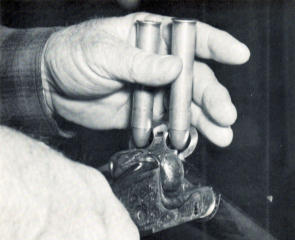| DUGABOY1 |
| (.400 member) |
| 21/01/04 04:18 PM |

|
|
|
I hate to disalusion you, 4seventy, but barrel time is always involved in the regulation of a double rifle durring it's factory regulation as well. The time the bullet stays in the barrel, in relation to recoil is what determines how much the barrels converge, and how they point at the the target in relation to the sights.

True it is much easier to do the regulation (adjusting the barrels to a known load) than it is to find the proper load for a rifle already regulated to a unknown load. Calling the working up of a load to shoot to the barrels is mistakenly called "REGULATION", by most folks, but that is not a proper phrase. Regulation is a phycical process, of actually adjusting the convergence of the barrels.
The .22 Lr is easier to regulate because the muzzel flip, high velocity, is not involved, and they simply must be convereged or spread till they both hit together on the target. The elevation isn't a problem till the final sights are installed.
The hardest chambering to "REGULATE" is one that is very fast. This makes the barrel time so short, the the adgustments are so finite, that it is almost imposible. H&H built a double for someone chambered for .225 Winchester, and it took them over 100 rounds to get it shooting, because of the 3600 fps it developed.
PS:
4seventy, i didn't see your last question till I had already posted, Sorry!
The final regulation can only be done before the ribs, on a .22 Lr rifle, again because the muzzle flip is not involved. A cartridge that has a large amount of recoil is also regulated mostly before the ribs are installed, then a final regulation is done after. Sometimes it is needed, and some times it isn't, especially, when done by a REAL regulator. Most factory regulators can join the barrels very close to their final fit, by an educated guess, from past experience!
